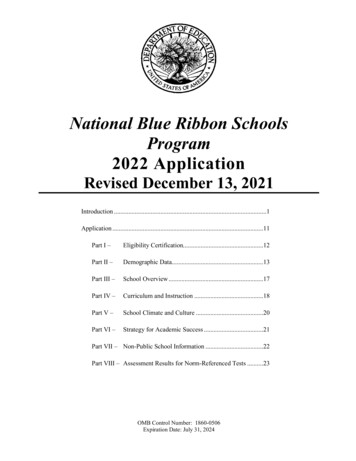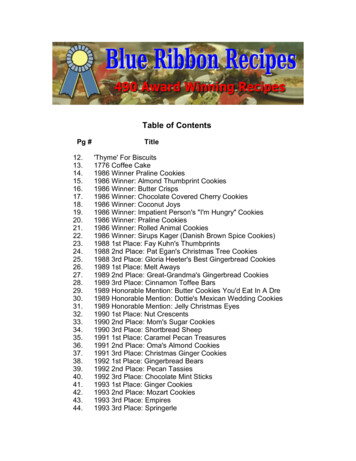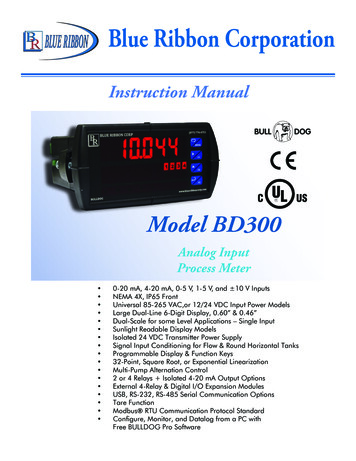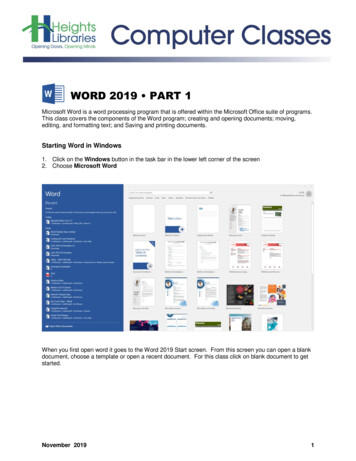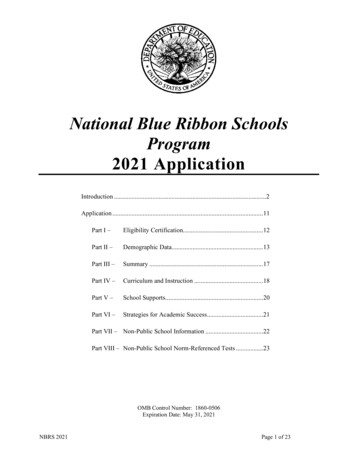
Transcription
National Blue Ribbon SchoolsProgram2021 ApplicationIntroduction .2Application . 11Part I –Eligibility Certification.12Part II –Demographic Data.13Part III –Summary . 17Part IV –Curriculum and Instruction .18Part V –School Supports.20Part VI –Strategies for Academic Success .21Part VII – Non-Public School Information .22Part VIII – Non-Public School Norm-Referenced Tests .23OMB Control Number: 1860-0506Expiration Date: May 31, 2021NBRS 2021Page 1 of 23
2021 National Blue Ribbon Schools ProgramA National Recognition Program for American SchoolsSince 1982, the U.S. Department of Education’s National Blue Ribbon Schools Program has honoredAmerica’s most successful public and non-public elementary, middle, and high schools. A National BlueRibbon Schools flag waving overhead has become a trademark of excellence, a symbol of qualityrecognized by everyone from parents to policy-makers in thousands of communities.The National Blue Ribbon Schools Program recognizes 1) schools whose students achieve at very highlevels or 2) schools making significant progress in closing achievement gaps among different groups ofstudents. The Program sets a standard of excellence for all schools striving for the highest level ofachievement.National Blue Ribbon Schools are honored each year at a recognition ceremony in Washington, DC. Theapplications from the award-winning schools are posted on the Department’s website. A small group ofNational Blue Ribbon Schools are visited each year to highlight educational practices that have beenespecially successful.Public School Nomination ProcessFor public schools, the Secretary invites Chief State School Officers (CSSOs), including the District ofColumbia (DC), Puerto Rico, the Virgin Islands, the Department of Defense Education Activity (DoDEA),and the Bureau of Indian Education (BIE), to nominate schools. In this document, the title CSSO will referto the chief school officers in the states and in the public education entities named above.In submitting the list of nominated schools, CSSOs must certify that the schools meet the minimumrequirements established by the Department for nomination. As described below, CSSOs must also rely ontheir own education accountability and assessment systems to identify schools for submission to theSecretary.Disadvantaged Backgrounds of Students. At least one-third of the public schools nominated by each statemust be schools with a high percentage of students from disadvantaged backgrounds. A student from a“disadvantaged background” is defined by the CSSO of each state. The definition may include economicallydisadvantaged students, that is, students who are eligible for free and reduced-price school meals; studentswith disabilities; students who are limited English proficient; migrant students; and/or students receivingservices under Title I of the Elementary and Secondary Education Act, as amended by the Every StudentSucceeds Act of 2015. “High percentage” means at least 40 percent unless a state has found that thiscriterion restricts the number of schools available for nomination. Such a state may propose to use apercentage lower than 40 percent so long as the proposed percentage is no lower than the state’s overall(average) percentage of students from disadvantaged backgrounds as defined by the state. The Departmentalso recommends nominated schools reflect the demographic and geographic diversity of the state’s schoolage population.Each state’s nomination criteria must pertain equally to all schools nominated by the state.A school may be nominated in either of two performance award categories: Exemplary High Performingand Exemplary Achievement Gap Closing. The student performance criteria that a school must meet inorder to be nominated in each of these two categories are described below.NBRS 2021Page 2 of 23
1) Exemplary High Performing Schools. “High performing” is defined by the CSSO of each state, butat a minimum means that the school meets the performance criteria summarized in the followingtable:CriterionThreshold1a. Whole SchoolPerformanceTop 15%in the State1b. SchoolSubgroupPerformanceTop 40%in the Statefor EachSubgroup1c. High SchoolGraduationRate and CCRMeasureTop 15%in the StateMeasure for Ranking SchoolsOption 1Option 2Option 3Reading\ELAReading\ELAComposite Scoreand Mathand aratelyCombinedMath, and OtherMeasuresReading\ELAReading\ELAComposite Scoreand Mathand aratelyCombinedMath, and OtherMeasuresGraduation Rate Graduation Rate Composite Scoreand CCRand CCRCombiningMeasureMeasureGraduation RateSeparatelyCombinedand CCRMeasure withReading/ELA,Math and OtherMeasures1a. Whole School Performance. All schools are ranked 1 based on the performance of all studentsin the school on the most recently administered state assessments in reading (or Englishlanguage arts) and mathematics. 2 The state may rank schools on these two subjects separatelyor rank schools on the two subjects combined (e.g., sum or average). The state may alsocombine performance on these assessments with other measures of student performance (e.g.,student growth on state assessments, performance on state assessments in other subjects,graduation rates, or other indicators in the state’s accountability system) and rank the schools onthe resulting composite score/index. Schools in the top 15 percent of each ranking forreading/ELA and mathematics (separately, combined, or as part of a composite score/index)meet the threshold for this criterion.1b. School Subgroup Performance. For each of the state’s subgroups, 3 all schools are rankedbased on the performance of the students in that subgroup on the most recently administeredstate assessments in reading (or English language arts) and mathematics (separately, combined,or as part of a composite score/index). Schools in the top 40 percent of each ranking for each oftheir sufficiently large subgroups 4 meet the threshold for this criterion.1c. High School Graduation Rate and CCR Measure. All high schools are ranked based on thestate’s 2018-2019 graduation rate and on the most recent measure of CCR (separately,The state may rank schools based on all grades served or rank schools separately for different grade spans or grades.This includes students tested with accommodations.3States are encouraged to nominate schools based on the performance of the subgroups included in their accountabilitysystem.4A “sufficiently large subgroup” is one that meets the minimum “n-size” for subgroups in the state’s accountabilitysystem.NBRS 2021Page 3 of 2312
combined, or as part of a composite score/index). 5 High schools in the top 15 percent of eachranking meet the threshold for this criterion.2) Exemplary Achievement Gap Closing Schools: “Achievement gap closing” is defined by the CSSOof each state, but at a minimum means that the school meets the performance criteria summarized inthe following table:CriteriaThreshold2a. SchoolSubgroupImprovementTop 15% inthe State forOne or MoreSubgroups2b. SchoolSubgroupPerformanceTop 40% inthe State forEachSubgroup2c. High SchoolSubgroupGraduationRate andCCRMeasureTop 40% inthe State forEachSubgroup2d. WholeSchoolImprovementEquals orExceedsWhole StateImprovementMeasure for Ranking SchoolsOption 1Option 2Option 3Improvement in Improvement in Improvement inReading\ELAReading\ELAComposite Scoreand Mathand MathCombiningSeparatelyCombinedReading\ELA,Math, and OtherMeasuresReading\ELAReading\ELAComposite Scoreand Mathand aratelyCombinedMath, and OtherMeasuresGraduation Rate Graduation Rate Composite Scoreand CCRand CCRCombiningMeasureMeasureGraduation RateSeparatelyCombinedand CCRMeasure withReading/ELA,Math and OtherMeasuresImprovement in Improvement in Improvement inReading\ELAReading\ELAComposite Scoreand Mathand MathCombiningSeparatelyCombinedReading\ELA,Math, and OtherMeasures2a. School Subgroup Improvement. For each of the state’s subgroups, 6 all schools are rankedbased on the increase in the performance 7 of that subgroup on the most recently administeredstate assessments in reading (or English language arts) and mathematics (separately, combined,or as part of a composite score/index), comparing the results for the most recent school year inwhich the state assessments were administered to the results for the school year 2-4 yearsbefore. Schools in the top 15 percent of each ranking for at least one of their sufficiently largesubgroups 8 meet the threshold for this criterion.2b. School Subgroup Performance. For each of the state’s subgroups, all schools are ranked basedon the performance of the students in that subgroup on the most recently administered stateassessments in reading (or English language arts) and mathematics (separately, combined, or asIf a state uses a composite in 1a that includes graduation rate and CCR measure(s) for ranking high schools, theircomposite scores may be identical to their composite scores used in 1c.6States are encouraged to nominate schools based on the performance of the subgroups included in their accountabilitysystem.7Three different ways for calculating the increase in performance of subgroups are described in Appendix B.8A “sufficiently large subgroup” is one that meets the minimum “n-size” for subgroups in the state’s accountabilitysystem.NBRS 2021Page 4 of 235
part of a composite score/index). Schools in the top 40 percent of each ranking for each of theirsufficiently large subgroups meet the threshold for this criterion.2c. High School Subgroup Graduation Rate and CCR Measure. For each of the state’ssubgroups, all high schools are ranked based on the state’s graduation rate for the 2018-2019school year and on the most recent measure of CCR (separately, combined, or as part of acomposite score/index). High schools in the top 40 percent of this ranking for each of theirsufficiently large subgroups meet the threshold for this criterion.2d. Whole School Improvement. In order for a school to meet the threshold for this criterion, theincrease in the performance of all students in the school on state assessments in reading (orEnglish language arts) and mathematics (separately, combined, or as part of a compositescore/index), comparing the results for the most recent school year in which the stateassessments were administered to the results for the school year 2-4 years before, must equal orexceed the increase in the performance of all public school students in the state over the sameperiod.In addition to meeting the above student performance requirements, a nominated school must, in most cases,have at least 100 students enrolled and have assessment data for at least 10 students in each tested grade forboth reading (or English language arts) and mathematics. States with a large percentage of schools withfewer than 100 students enrolled may include up to a similar percentage of these schools in theirnominations. However, these schools must have assessment data for at least 10 students in each tested gradefor both reading (or English language arts) and mathematics.All nominated public schools must meet the state’s goals for interim progress in the state accountabilitysystem or other performance targets that are set by the state for the school year in question in at least reading(or English language arts), mathematics, graduation rates, and possibly other academic indicators, for the allstudents group. Additionally, nominated schools must have assessment participation rates of at least 95percent, using the most recent accountability results available, for the all students group. Finally, in order tomeet all school performance eligibility requirements, all nominated public schools must be certified by thestate prior to the September 2021 announcement of National Blue Ribbon Schools by the U. S. Secretary ofEducation.Other Eligibility Requirements for National Blue Ribbon Schools1. The school configuration must include one or more of grades K-12. Schools located on the samecampus (physical location and mailing address) must apply as an entire school (i.e. K-8; 6-12; K-12school). Two (or more) schools located on separate campuses, must apply individually even if theyhave the same principal. A single school located on multiple campuses with one principal must applyas an entire school.2. The school has been in existence for five full years, that is, from at least September 2015 and gradesparticipating in statewide assessments must have been part of the school for at least the three yearsprior to September 2019.3. The nominated school has not received the National Blue Ribbon Schools award in the past five years:2016, 2017, 2018, 2019, or 2020.4.The nominated school has no history of testing irregularities, nor have charges of irregularities beenbrought against the school at the time of nomination. If irregularities are later discovered and provenby the state, the U.S. Department of Education reserves the right to disqualify a school’s applicationand/or rescind a school’s award.5. The nominated school has not been identified by the state as “persistently dangerous” within the lasttwo years.6. The nominated school or district is not refusing Office of Civil Rights (OCR) access to informationnecessary to investigate a civil rights complaint or to conduct a district-wide compliance review.NBRS 2021Page 5 of 23
7. The OCR has not issued a violation letter of findings to the school district concluding that thenominated school or the district as a whole has violated one or more of the civil rights statutes. Aviolation letter of findings will not be considered outstanding if OCR has accepted a corrective actionplan from the district to remedy the violation.8. The U.S. Department of Justice does not have a pending suit alleging that the nominated school or theschool district as a whole has violated one or more of the civil rights statutes or the Constitution’sequal protection clause.9. There are no findings of violations of the Individuals with Disabilities Education Act in a U.S.Department of Education monitoring report that apply to the school or school district in question; or ifthere are such findings, the state or district has corrected, or agreed to correct, the findings.Once the Secretary receives the nominations from the CSSOs, nominated schools are invited to submitapplications for recognition as National Blue Ribbon Schools.Non-Public School Nomination ProcessFor not-for-profit non-public schools, the Secretary invites the Council for American Private Education(CAPE) to nominate schools that meet the criteria for recognition. Non-public schools interested in applyingfor nomination should contact the Council for American Private Education directly. CAPE must ensure andcertify that the schools meet the criteria before submitting nominations to the Department.Non-public schools are eligible for National Blue Ribbon recognition if they meet the following criteria:1) Exemplary High Performing Schools: “High performing” means:(a) That the achievement of the school’s students in the most recent year tested places the school inthe top 15 percent in the nation in reading and mathematics as measured by a nationally normedtest or in the top 15 percent of its state as measured by a state test.(b) Disaggregated results for student groups, including students from disadvantaged backgrounds,must be similar to the results for all students tested.(c) For the most recent year in which graduation rates are available, the graduation rate for nonpublic high schools must be 95% or higher.A student from a “disadvantaged background” may include economically disadvantaged students, that is,students who are eligible for free and reduced-price school meals; students with disabilities; students whoare limited English proficient; migrant students; and/or students receiving services under Title I of theElementary and Secondary Education Act, as amended by the Every Student Succeeds Act of 2015.For information on the nomination process and timeline for CAPE, non-public schools representativesshould consult the Council for American Private Education Website.Public and Non-Public Nomination Allocations and Eligibility for Public andNon-Public SchoolsStates and public entities, including DC, Puerto Rico, the Virgin Islands, BIE, and DoDEA, are allocated anumber of National Blue Ribbon School nominations based on total K-12 student enrollment and number ofpublic schools. Allocations range from a minimum of 3 schools to a maximum of 35. CAPE may nominateup to 50 non-public schools. A total of 420 public and non-public schools could be nominated each year.Eligible schools, then, are those submitted by authorized nominators that meet all National Blue RibbonSchools Program criteria and requirements and have completed a comprehensive, high quality applicationaccording to Program timelines.NBRS 2021Page 6 of 23
Application Process for Nominated SchoolsOnce the Department receives the nominations from the CSSOs, the Secretary extends an invitation to thenominated schools to apply.The nominators are encouraged to contact principals of selected schools prior to nomination to verifyprincipals’ commitment and to review completed applications prior to submission to ensure that recognizedschools will be outstanding models of excellence for their states and for the National Blue Ribbon SchoolsProgram. The Secretary reserves the right to initiate site visits to schools to document educational practicesas well as to verify the accuracy of data.NBRS 2021Page 7 of 23
Timeline for 2021 National Blue Ribbon SchoolsDateDueSeptember, 2020The Secretary of Education sends a letter of invitation to the CSSOs and CAPErequesting nominations of eligible schools.October, 2020Conduct webinar/TA conference calls to review guidance and application withliaisons.October 30, 2020Pre-registrations of non-public schools are due.December 31, 2020Nomination processes and data for public schools being considered fornomination from CSSOs are due to the Department.January 6, 2021Hard copy of non-public school applications and assessment results are due toCAPE.January 11-15, 2021Nomination processes and data for public schools being considered fornomination are reviewed by ED and a NBRS Assessment Panel for alignmentwith the general eligibility criteria of the National Blue Ribbon SchoolsProgram.February 3, 2021Approved public school nominations are entered by states into online portal.February 8, 2021The Department invites public schools nominated by CSSOs to apply forrecognition as National Blue Ribbon Schools.February 19, 2021CAPE selects non-public school nominations.April 9, 2021Completed public and non-public school applications are due to theDepartment.April-June, 2021Applications are reviewed for completeness, quality, and accuracy.August, 2021States certify that nominated public schools have met all eligibilityrequirements.September, 2021The Secretary of Education announces the 2021 National Blue Ribbon Schools(public and non-public).November, 2021Two representatives from each school, the principal and a teacher, attend therecognition ceremony in Washington, DC.Important Considerations for Completing the National Blue Ribbon School Online Application1. The entire application must be submitted through the secure online school portal at: National BlueRibbon Schools Program.2. A School ID username and Password are necessary to access the online application form in the secureschool portal.3. Narrative responses to application questions must address the topic succinctly. No attachments to theonline application can be submitted. Bulleted sections are not acceptable.4. Tables, charts, graphs, photos cannot be accommodated by the online application.5. Online instructions must be followed when copying/pasting text from Word to the online application;formatting may be changed.6. Saving work frequently is necessary to protect the “work in progress.”NBRS 2021Page 8 of 23
7. Printing the application for review is possible before and after the final submission.8. Public and non-public school applicants must convert the “electronically” signed cover page of theapplication to a PDF file and upload the PDF via the online application portal.9. All public and non-public school applications must be completed and submitted by Program timelines.No changes can be made to applications after submission.Instructions for completing the application are provided as online help text. Assistance is available forschool applicants through the National Blue Ribbon Schools Technical Assistance Team. For help innavigating the online system, or questions regarding responses to the narrative or data items, use thecontact form located at: National Blue Ribbon Schools Program.NBRS 2021Page 9 of 23
Paperwork Burden StatementAccording to the Paperwork Reduction Act of 1995, no persons are required to respond to a collection ofinformation unless such collection displays a valid OMB control number. The valid OMB control numberfor this information collection is 1860-0506. The expiration date is 5/31/2021. The time required tocomplete this information collection is estimated to average 39.75 hours per response, including the time toreview instructions, search existing data resources, gather the data needed, and complete and review theinformation collection. If you have any comments concerning the accuracy of the time estimate(s) orsuggestions for improving this form, please write to: U.S. Department of Education, Washington, DC20202-4651. If you have comments or concerns regarding the status of the individual submission of thisform, contact Aba Kumi, (Aba.Kumi@ed.gov) Director, National Blue Ribbon Schools Program, Office ofCommunications and Outreach, U.S. Department of Education, 400 Maryland Ave., SW, Room 5E103,Washington, DC 20202-8173.NBRS 2021Page 10 of 23
2021 National Blue Ribbon Schools Program[ ] Public or [ ] Non-publicFor Public Schools only: (Check all that apply) [ ] Title I [ ] Charter [ ] Magnet [ ] ChoiceName of Principal(Specify: Ms., Miss, Mrs., Dr., Mr., etc.) (As it should appear in the official records)Official School NameSchool Mailing Address(As it should appear in the official records)(If address is P.O. Box, also include street address.)CityStateZip Code 4 (9 digits total)CountyTelephone ( )Fax ( )Web site/URLE-mailTwitter HandleFacebook PageGoogle YouTube/URLBlogOther Social Media LinkI have reviewed the information in this application, including the eligibility requirements on page 2 (Part IEligibility Certification), and certify, to the best of my knowledge, that it is accurate.Date(Principal’s Electronic Signature)Name of Superintendent* E-mail(Specify: Ms., Miss, Mrs., Dr., Mr., Other)District NameTel.()I have reviewed the information in this application, including the eligibility requirements on page 2 (Part IEligibility Certification), and certify, to the best of my knowledge, that it is accurate.(Superintendent’s Electronic Signature)Name of School BoardPresident/ChairpersonDate(Specify: Ms., Miss, Mrs., Dr., Mr., Other)I have reviewed the information in this application, including the eligibility requirements on page 2 (Part IEligibility Certification), and certify, to the best of my knowledge, that it is accurate.(School Board President’s/Chairperson’s Electronic Signature)DateThe original signed cover sheet only should be converted to a PDF file and uploaded via the online portal.*Non-public Schools: If the information requested is not applicable, write N/A in the space.NBRS 2021Page 11 of 23
PART I – ELIGIBILITY CERTIFICATIONThe signatures on the first page of this application (cover page) certify that each of the statements below,concerning the school’s eligibility and compliance with U.S. Department of Education and National BlueRibbon Schools requirements, are true and correct.1. All nominated public schools must meet the state’s performance targets in reading (or Englishlanguage arts) and mathematics and other academic indicators (i.e., attendance rate and graduation rate),for the all students group, including having participation rates of at least 95 percent using the mostrecent accountability results available for nomination.2. To meet final eligibility, all nominated public schools must be certified by states prior to September2020 in order to meet all eligibility requirements. Any status appeals must be resolved at least twoweeks before the awards ceremony for the school to receive the award.3. The school configuration must include one or more of grades K-12. Schools located on the samecampus (physical location and mailing address) must apply as an entire school (i.e. K-8; 6-12; K-12school). Two (or more) schools located on separate campuses, must apply individually even if they havethe same principal. A single school located on multiple campuses with one principal must apply as anentire school.4. The school has been in existence for five full years, that is, from at least September 2015 and eachtested grade must have been part of the school for the past three years.5. The nominated school has not received the National Blue Ribbon Schools award in the past fiveyears: 2016, 2017, 2018, 2019 or 2020.6. The nominated school has no history of testing irregularities, nor have charges of irregularities beenbrought against the school at the time of nomination. If irregularities are later discovered and proven bythe state, the U.S. Department of Education reserves the right to disqualify a school’s application and/orrescind a school’s award.7. The nominated school has not been identified by the state as “persistently dangerous” within the lasttwo years.8. The nominated school or district is not refusing Office of Civil Rights (OCR) access to informationnecessary to investigate a civil rights complaint or to conduct a district-wide compliance review.9. The OCR has not issued a violation letter of findings to the school district concluding that thenominated school or the district as a whole has violated one or more of the civil rights statutes. Aviolation letter of findings will not be considered outstanding if OCR has accepted a corrective actionplan from the district to remedy the violation.10. The U.S. Department of Justice does not have a pending suit alleging that the nominated school orthe school district, as a whole, has violated one or more of the civil rights statutes or the Constitution’sequal protection clause.11. There are no findings of violations of the Individuals with Disabilities Education Act in a U.S.Department of Education monitoring report that apply to the school or school district in question; or ifthere are such findings, the state or district has corrected, or agreed to correct, the findings.NBRS 2021Page 12 of 23
PART II - DEMOGRAPHIC DATAData should be provided for the current school year (2020-2021) unless otherwise stated.DISTRICT (Question 1 is not applicable to non-public schools.)1.Number of schools in the district(per district designation):Elementary schools (includes K-8)Middle/Junior high schoolsHigh schoolsK-12 schoolsTOTALSCHOOL (To be completed by all schools. Only include demographic data for the nominated school, notthe district.)2. Category that best describes the area where the school is located. If unsure, refer to NCES database forcorrect category: https://nces.ed.gov/ccd/schoolsearch/ (Find your school and check “Locale”)[ ][ ][ ]3.Urban (city or town)SuburbanRuralNumber of students as of October 1, 2020 enrolled at each grade level or its equivalent at the school.Include all students enrolled, in-person, participating in a hybrid model, or online only. If onlineschooling or other COVID-19 school issues make this difficult to obtain, provide the most accurate andup-to-date information available:GradePreK*K123456789101112 or higherTotal Students# ofMales# ofFemalesGradeTotal*Schools that house PreK programs should count preschool students only if the schooladministration is responsible for the program.4.Racial/ethnic composition of% American Indian or Alaska Nativethe school (if unknown, estimate): % Asian% Black or African American% Hispanic or Latino% Native Hawaiian or Other Pacific Islander% White% Two or more races100 % TotalNBRS 2021Page 13 of 23
(Only these seven standard categories should be used to report the racial/ethnic composition of your school. The Final Guidance onMaintaining, Collecting, and Reporting Racial and Ethnic Data to the U.S. Department of Education published in the October 19,2007 Federal Register provides definitions for each of the seven categories.)5.Student turnover, or mobility rate, during the 2019-2020 school year: %If the mobility rate is above 15%, please explain:This rate should be calculated using the grid below. The answer to (6) is the mobility rate.Steps For Determining Mobility Rate(1) Number of students who transferred to the school after October1, 2019 until the end of the 2019-2020 school year(2) Number of students who transferred from the school afterOctober 1, 2019 until the end of the 2019-2020 school year(3) Total of all transferred students [sum of rows (1) and (2)](4) Total number of students in the school as of October 1, 2019(5) Total transferred students in row (3) divided by total students inro
2021 National Blue Ribbon Schools Program A National Recognition Program for American Schools Since 1982, the U.S. Department of Education's National Blue Ribbon Schools Program has honored America's most successful public and non-public elementary, middle, and high schools. A National Blue
